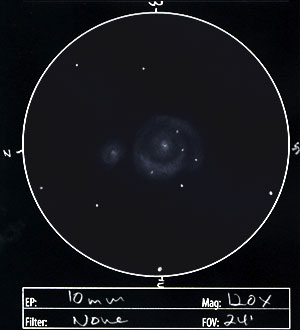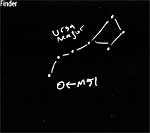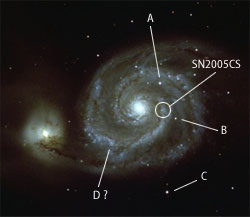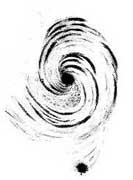
Observation Notes:
 Such a beautiful galaxy; such a painful observation. M51’s large, circular extent reached almost to smaller NGC 5195. The were both arranged in a north-south direction. Both had bright, distinct cores. NGC 5195 looked to be about one-quarter the diameter of M51. My initial impression of M51 at 38X is that it had a tantalizingly mottled surface. At 120X, averted vision revealed its spiral arms. They emanated from the core and wrapped clockwise. For the outside rim, the northeast and southwest edges were the brightest. For the inner portions, the south side was most distinct. NGC 5195 didn’t look entirely round. It seemed that the side facing M51 had a harder edge to it.
Such a beautiful galaxy; such a painful observation. M51’s large, circular extent reached almost to smaller NGC 5195. The were both arranged in a north-south direction. Both had bright, distinct cores. NGC 5195 looked to be about one-quarter the diameter of M51. My initial impression of M51 at 38X is that it had a tantalizingly mottled surface. At 120X, averted vision revealed its spiral arms. They emanated from the core and wrapped clockwise. For the outside rim, the northeast and southwest edges were the brightest. For the inner portions, the south side was most distinct. NGC 5195 didn’t look entirely round. It seemed that the side facing M51 had a harder edge to it.
Hunting for the supernova, SN 2005cs, was tough. There was one bright foreground star southwest of M51’s core, labeled A, that held steady during the observation. Another consistent point was a star southeast and outside the galaxy, labeled C. Less certain were a couple intermittently visible points that I marked as B and D in the labeled sketch. The point marked B does correspond roughly to a point in the accompanying astrophoto and is designated USNO 1350-08287169. Try as I may, I could not come up with a designation for the star labeled ‘A’. I was surprised by this and chalk it up as yet another mark of my inexperience using tools like Simbad and VisieR. Oh well.


Photo: Copyright Association of Universities for Research in Astronomy Inc. (AURA), all rights reserved. Todd Boroson/AURA/NOAO/NSF
Ultimately, I was able to detect intermittent twinklings of SN 2005cs through the rather poor seeing. It consistently showed up directly south of the core, along an imaginary line drawn between the core of both galaxies, and embedded in the inner spiral arm just outside the core. This matches pretty neatly with astro photography of the supernova and while it required much patience and eye strain to pick up repeat glimpses of it in the same spot, I feel fairly confident I spotted it. Although I sure wouldn’t mind getting a steadier view of it in a larger scope.
Factoids:
M51 is a spiral galaxy that is a member of a small group of galaxies including M63 and 6 other less prominent members. This group is estimated to lie about 37 million light years away (with a more recent estimate of 31 million light years from STScI). Under present theory, the pronounced spiral structure of the galaxy is due to an ongoing interaction with neighboring NGC 5195. This interaction would have disturbed gasses in M51, causing a burst of star formation in the galactic arms.
 M51 was discovered by Charles Messier in 1773. The catalog description says, “It is double, each has a bright center, which are separated 4’35”. The two ‘atmospheres’ touch each other, the one is even fainter than the other.” William Herschel assigned NGC 5195 its own number (H I.186). M51 is the first galaxy in which spiral structure was discovered, in 1845 by Lord Rosse. His meticulous and beautiful painting of the galaxy gave rise to the moniker “Lord Rosse’s Question Mark”.
M51 was discovered by Charles Messier in 1773. The catalog description says, “It is double, each has a bright center, which are separated 4’35”. The two ‘atmospheres’ touch each other, the one is even fainter than the other.” William Herschel assigned NGC 5195 its own number (H I.186). M51 is the first galaxy in which spiral structure was discovered, in 1845 by Lord Rosse. His meticulous and beautiful painting of the galaxy gave rise to the moniker “Lord Rosse’s Question Mark”.
Supernova 2005cs was discovered June 27, 2005 by Wolfgang Kloehr, an amateur astronomer from Germany. It was mag 13.5 and rising at the time. It was classified as a type II supernova, based on analysis of its spectrum.
| Subject | M51 (NGC 5194), SN 2005cs |
| Classification | M51: Spiral Galaxy (Type Sc) SN 2005cs: Supernova (Type II) |
| Position* | M51: Canes Venatici [RA: 13:29.9 / Dec: +47:12] SN 2005cs: Canes Venatici [RA: 13:29:52.85 / Dec: +47:10:36.3] |
| Size* | M51: 11′ x 7′ |
| Brightness* | M51: 8.4 NGC 2005cs: 13.5 |
| Date/Time | July 4, 2005 – 11:30 PM (July 5, 2005 – 06:30 UT) |
| Observing Loc. | Anderson Mesa, Arizona |
| Instrument | Orion SVP 6LT Reflector (150 mm dia./1200 mm F/L) |
| Eyepieces/Mag. | 32 mm (38X), 10 mm (120X), 10 mm + 2X (240X) |
| Conditions | Clear, breezy |
| Seeing | 3/10 |
| Transparency | Mag 6.5+ NELM |
| Sources | SEDS |
*Based on published data.
Hi Mr. Perez,
This is a wonderful sketch! I like the detail you were able to capture, and I hope you were able to get a look at the recent 2011dh in M51 as well.
Clear skies,
Brandon Doyle
Thanks Brandon, unfortunately I didn’t get a look at the 2011 supernova in M51. I always enjoy your sketches, keep them coming!